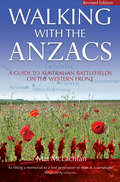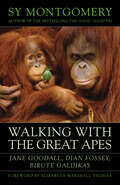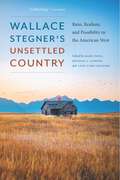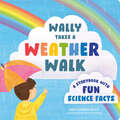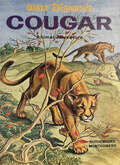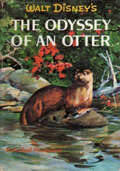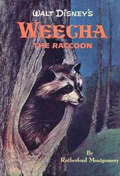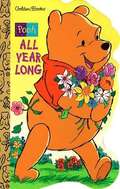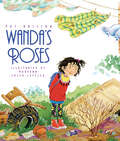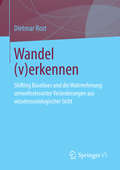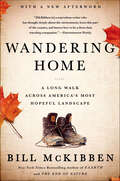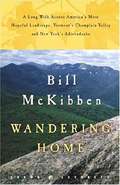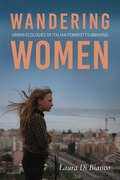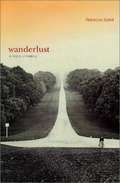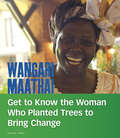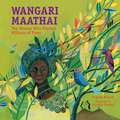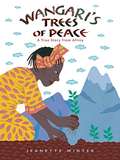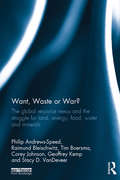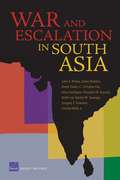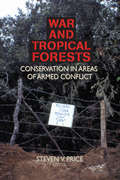- Table View
- List View
Walking with the ANZACS: The authoritative guide to the Australian battlefields of the Western Front
by Mat McLachlan'[Mat McLachlan's] knowledge of the front is comprehensive' - Sydney Morning HeraldA complete guide to the Australian battlefields of the Western Front 1916-18.Walking with the ANZACs aims to become the new essential companion for Australians visiting the Western Front. Each of the 14 most important Australian battlefields is covered with descriptions of the battles and Australia?s involvement in it.The book presents a well-illustrated walking tour across the old battlefields. The tours are designed along easily accessible walking routes and show readers battlefield landmarks that still exist, memorials to the men who fought there and the cemeteries where many of them still lie. In this way the visitor will see the battlefield in much the same way as the original ANZACs did, and gain a greater appreciation of the site?s significance. Importantly, the tours are not written for military experts, but for ordinary visitors whose military knowledge may be limited.More than just a handy travel guide, Walking with the ANZACs is an absorbing read for armchair travellers and students of the First World War who may not have had the opportunity to visit the battle fields and walk in the footsteps of the first ANZACs.
Walking with the Great Apes: Jane Goodall, Dian Fossey, Biruté Galdikas
by Sy MontgomeryFrom the personal to the primate, Sy Montgomery–acclaimed author of The Soul of an Octopus and The Good Good Pig–explores the science, wisdom, and living experience of three of the greatest scientists of the twentieth century.Three astounding women scientists have in recent years penetrated the jungles of Africa and Borneo to observe, nurture, and defend humanity&’s closest cousins. Jane Goodall has worked with the chimpanzees of Gombe for nearly 50 years; Diane Fossey died in 1985 defending the mountain gorillas of Rwanda; and Biruté Galdikas lives in intimate proximity to the orangutans of Borneo. All three began their work as protégées of the great Anglo-African archeologist Louis Leakey, and each spent years in the field, allowing the apes to become their familiars–and ultimately waging battles to save them from extinction in the wild.Their combined accomplishments have been mind-blowing, as Goodall, Fossey, and Galdikas forever changed how we think of our closest evolutionary relatives, of ourselves, and of how to conduct good science.
Wallace Stegner's Unsettled Country: Ruin, Realism, and Possibility in the American West
by Michael J. Lansing Mark Fiege Leisl Carr ChildersWallace Stegner is an iconic western writer. His works of fiction, including the Pulitzer Prize–winning Angle of Repose and Big Rock Candy Mountain, as well as his nonfiction books and essays introduced the beauty and character of the American West to thousands of readers. Wallace Stegner&’s Unsettled Country assesses his life, work, and legacy in light of contemporary issues and crises. Along with Stegner&’s achievements, the contributors show how his failures offer equally crucial ways to assess the past, present, and future of the region. Drawing from history, literature, philosophy, law, geography, and park management, the contributors consider Stegner&’s racial liberalism and regional vision, his gendered view of the world, his understandings of conservation and the environment, his personal experience of economic collapse and poverty, his yearning for community, and his abiding attachment to the West. Wallace Stegner&’s Unsettled Country is an even-handed reclamation of Stegner&’s enduring relevance to anyone concerned about the American West&’s uncertain future.
Walleye: A Beautiful Fish of the Dark
by Paul J. RadomskiWalleye, the holy grail of game fish: on catching them, understanding their biology and history, and ensuring their survival Among the more than 34,000 species of fish, few have the walleye&’s following—among anglers and diners, states conferring official status on the fish, and towns battling for recognition as the Walleye Capital of the World. And among those passionate fans, few know the walleye as well as Paul J. Radomski does—a fisheries biologist, lake ecology scientist, and old fisherman. In Walleye: A Beautiful Fish of the Dark he unspools the mysteries of this fascinating fish.Radomski looks at walleye from every angle, with something to say to the curious naturalist, committed ecologist, and avid fishing enthusiast. People who view walleye as the &“lion of the lakes&” might be surprised to learn that rivers are their ancestral habitat. Some might wonder about the name &“wall-eye,&” a nod to an evolutionary adaptation to dark water environments. Others might simply ask: why walleye? What are they, where do they exist, how do they survive, and how have people come to depend on them? Radomski discusses the principles and pitfalls of managing this predator of the twilight (and the history and methods of doing so) and shares his informed perspective on when and where stocking is prudent. Finally, he explores three of the best walleye lakes: Winnebago, the largest inland walleye fishery in Wisconsin, and Mille Lacs and Red Lake in Minnesota.From the simple pleasures of fishing for walleye to the most pressing questions about how this species survives, this book is the best word on this beautiful fish of the dark.
Walls: Enclosure and Ethics in the Modern Landscape
by Thomas OlesStone walls, concrete walls, chain-link walls, border walls: we live in a world of walls. Walls mark sacred space and embody earthly power. They maintain peace and cause war. They enforce separation and create unity. They express identity and build community. Yard to nation, city to self, walls define and dissect our lives. And, for Thomas Oles, it is time to broaden our ideas of what they can--and must--do. In Walls, Oles shows how our minds and our politics are shaped by-and shape-our divisions in the landscape. He traces the rich array of practices and meanings connected to the making and marking of boundaries across history and prehistory, and he describes how these practices have declined in recent centuries. The consequence, he argues, is all around us in the contemporary landscape, riven by walls shoddy in material and mean in spirit. Yet even today, Oles demonstrates, every wall remains potentially an opening, a stage, that critical place in the landscape where people present themselves and define their obligations to one another. In an evocative epilogue, Oles brings to life a society of productive, intentional, and ethical enclosure--one that will leave readers more hopeful about the divided landscapes of the future.
Wally Takes a Weather Walk: A Storybook with Fun Science Facts
by Bree Sunshine SmithEngage with the wonderful world of sunshine, rainbows, thunder, and snow as you learn fun facts with Wally! A first weather book for toddlers.Wally Takes a Weather Walk teaches toddlers the science behind what they see outside. What is wind? Why are there two rainbows? What makes snowflakes unique? Follow inquisitive Wally as he walks through summer, fall, winter, and spring, picking up facts about the seasons and weather conditions as he interacts with the natural world. Each page is a chance to spark curiosity around the magic waiting just beyond your front door. • A RAINBOW ASSORTMENT OF STEM FACTS: What does a toddler love more than asking &“Why?&” Here, weather questions are answered with scientific facts about each season. • A LIGHTNING-SMART AUTHOR: The only weather book for toddlers written by an Emmy Award–winning broadcast meteorologist, Bree Sunshine Smith (real name), accredited by the National Weather Association and the American Meteorological Society. • SUN, SNOW, AND ALL FIVE SENSES: A whimsical story helps toddlers stay engaged as they use all five senses to leap into a pile of leaves, taste snowflakes on their tongue, and spot a double rainbow!
Walt Disney's Cougar: A Fact-Fiction Nature Story (Walt Disney's Animal Adventures)
by Rutherford MontgomeryThe twin cougar cubs, Tawny and Chimbica, blinked in the spring sunshine at the entrance of the den they shared with their mother. They could not know that in the mountain wilderness that lay before them they would one day play a desperate game of life and death with a man whose rifle and trained team of hunting dogs had brought down many a marauding cougar . . . including their own father. Charlie Winters, the State Hunter, charged with protecting the lives and property of ranchers and sheepherders did not foresee that he would soon be matching wits with two snarling cougars among the jagged ridges of the high country. At the camp of a lonely sheepherder, the paths of hunter and hunted cross at last. The ensuing chase moves with breathtaking speed to a climax as sudden as a rifle’s crack, followed by the promise of new life and new adventure. The young reader will thrill to this fast-moving tale of life in the high wilderness, where nature’s never-ending struggle draws heightened excitement from the grandeur of its setting.
Walt Disney's The Odyssey of an Otter: A Fact-Fiction Nature Story
by Rutherford MontgomeryA Fact-Fiction nature story for children and young adults. Authorized edition based on a Walt Disney film presentation. This wonderful children's classic is about an otter who is captured by trappers, escapes, and has an eventful journey home to his family. Full of true-to-life details about otters.
Walt Disney's Weecha the Raccoon: A Fact-Fiction Nature Story (Walt Disney's Animal Adventures)
by Rutherford MontgomeryDuring a storm in a forest, a mother raccoon loses two of her three babies, and only Weecha is left. Soon, however, Weecha finds a new companion—Nubbin, an abandoned puppy. The mother raccoon accepts the puppy as though he were one of her own offspring. Together Weecha and Nubbin begin to learn the ways of wild creatures—hunting, fighting, outwitting their enemies—with the mother raccoon always nearby to rescue them from serious danger. But then Weecha and Nubbin are captured by a trapper, and for the first time the two young animals are on their own—swept up into exciting adventures in which they need all the courage and cunning they have learned. This warm, action-filled story is certain to hold the reader’s fascinated attention from the first to the very last page.
Walt Disney's Winnie-the-Pooh All Year Long
by A. A. MilnePooh and his friends find fun activities to do do all year long. Other books about Pooh and his friends are available from Bookshare.
Wanda's Roses
by Pat BrissonThis book about a child's simple faith is one that children will long remember--and adults will love to share.When Wanda discovers a thornbush growing in the empty lot at the corner of Fillmore and Hudson, she's quite sure it's a rosebush all ready to bloom. So she clears away the trash, checks on it every day, and brings water from the butcher shop across the street. But no roses appear. Wanda's neighbors and friends are all doubtful, but when she invites them to a tea party in her "rose garden" one day in June, they're in for a big surprise.
Wandel (v)erkennen
by Dietmar RostAngemessene Antworten auf die Problematik von Klimawandel und Artenschwund verlangen eine gesellschaftliche Wahrnehmung von langfristigen Veränderungen in Natur und Gesellschaft. Das Buch fragt nach den Formen, Grenzen und Konsequenzen der individuellen und kollektiven Wahrnehmung von Wandel und eröffnet ein wissenssoziologisch fundiertes Verständnis der (Nicht-)Wahrnehmung vergangener wie auch zukünftiger Veränderungsprozesse. Dies erfolgt zunächst in einer theoretischen Perspektive durch die Zusammenführung von relevanten Gesichtspunkten aus der Erinnerungs-, Generationen- und Zeitforschung. Das Konzept der ,,Shifting Baselines" liefert hierfür einen Ausgangspunkt. Daran anschließend blickt das Buch anhand von Aufschlüssen aus qualitativen Interviews auf die Wahrnehmung von Wandlungsprozessen unterschiedlicher Dynamik - von langsamem, rapidem und krassem (d. h. katastrophischem) Wandel -, um schließlich die Frage der Varianz und historischen Veränderung der Wahrnehmung von Wandel zu diskutieren.
Wandering Home: A Long Walk Across America's Most Hopeful Landscape
by Bill McKibben“A marvelous writer who has thought deeply about the environment, loves this part of the country, and knows how to be a first-class traveling companion.” —Entertainment WeeklyIn Wandering Home, one of his most personal books, New York Times–bestselling authorBill McKibben invites readers to join him on a hike from his current home in Vermont to his former home in the Adirondacks. Here he reveals that the motivation for his impassioned environmental activism is not high-minded or abstract, but as tangible as the lakes and forests he explored in his twenties, the same woods where he lives with his family today.Over the course of his journey McKibben meets with old friends and kindred spirits, including activists, writers, organic farmers, a vintner, a beekeeper, and environmental studies students, all in touch with nature and committed to its preservation. For McKibben, there is no better place than these woods to work out a balance between the wild and the cultivated, the individual and the global community, and to discover the answers to the challenges facing our planet today.“A short, lovely chronicle of a long hike, during which McKibben meditatively reflects on the relationship between nature and humanity. Nature writing at its best.” —Kirkus Reviews (starred review)“An enamoring and discerning look at one man’s compiled thoughts and researched knowledge on the Adirondacks as he strolls through its dense forests.” —All Points North“[McKibben] writes with his usual wry, approachable power about the Adirondacks, his chosen home . . . The book could single-handedly spur a rush of tourism to the Adirondack area—it’s that good.” —Publishers Weekly (starred review)
Wandering Home: A Long Walk Across America's Most Hopeful Landscape: Vermont's Champlain Valley and New York's Adirondacks
by Bill Mckibben<P>The acclaimed author of The End of Nature takes a three-week walk from his current home in Vermont to his former home in the Adirondacks and reflects on the deep hope he finds in the two landscapes. <P>Bill McKibben begins his journey atop Vermont's Mt. Abraham, with a stunning view to the west that introduces us to the broad Champlain Valley of Vermont, the expanse of Lake Champlain, and behind it the towering wall of the Adirondacks. <P>"In my experience," McKibben tells us, "the world contains no finer blend of soil and rock and water and forest than that found in this scene laid out before me--a few just as fine, perhaps, but none finer. And no place where the essential human skills--cooperation, husbandry, restraint--offer more possibility for competent and graceful inhabitation, for working out the answers that the planet is posing in this age of ecological pinch and social fray." <P>The region he traverses offers a fine contrast between diverse forms of human habitation and pure wilderness. <P>On the Vermont side, he visits with old friends who are trying to sustain traditional ways of living on the land and to invent new ones, from wineries to biodiesel. After crossing the lake in a rowboat, he backpacks south for ten days through the vast Adirondack woods. <P>As he walks, he contemplates the questions that he first began to raise in his groundbreaking meditation on climate change, The End of Nature: What constitutes the natural? How much human intervention can a place stand before it loses its essence? What does it mean for a place to be truly wild? <P>Wandering Home is a wise and hopeful book that enables us to better understand these questions and our place in the natural world. It also represents some of the best nature writing McKibben has ever done.
Wandering Women: Urban Ecologies of Italian Feminist Filmmaking (New Directions in National Cinemas)
by Laura Di BiancoWandering Women: Urban Ecologies of Italian Feminist Filmmaking explores the work of contemporary Italian women directors from feminist and ecological perspectives. Mostly relegated to the margins of the cultural scene, and concerned with women's marginality, the compelling films Wandering Women sheds light on tell stories of displacement and liminality that unfold through the act of walking in the city. The unusual emptiness of the cities that the nomadic female protagonists traverse highlights the absence of, and their wish for, life-sustaining communities. Laura Di Bianco contends that women's urban filmmaking—while articulating a claim for belonging and asserting cinematic and social agency—brings into view landscapes of the Anthropocene, where urban decay and the erasure of nature intersect with human alienation. Though a minor cinema, it is also a powerful movement of resistance against the dominant male narratives about the world we inhabit.Based on interviews with directors, Wandering Women deepens the understanding of contemporary Italian cinema while enriching the field of feminist ecocritical literature.
Wanderlust: A History of Walking
by Rebecca SolnitWhat does it mean to be out walking in the world, whether in a landscape or a metropolis, on a pilgrimage or a protest march? In "Wanderlust: A History of Walking", Rebecca Solnit draws together many histories -- of anatomical evolution and city design, of treadmills and labyrinths, of walking clubs and sexual mores -- to create a portrait of the range of possibilities for this most basic act. Arguing that walking as history means walking for pleasure and for political, aesthetic, and social meaning, Solnit homes in on the walkers whose everyday and extreme acts have shaped our culture, from the peripatetic philosophers of ancient Greece to the poets of the Romantic Age, from the perambulations of the Surrealists to the ascents of mountaineers. The first general "History of Walking", Solnit's book finds a profound relationship between walking and thinking, walking and culture, and argues for the necessity of preserving the time and space in which to walk in an ever-more automobile-dependent and accelerated world.
Wangari Maathai: Get to Know the Woman Who Planted Trees to Bring Change (People You Should Know)
by Lisa A. CraytonWangari Maathai was a fierce protector of the environment and a couragous advocate for women's rights, especially in her native country of Kenya. Her journey from a girl of rural Africa to college professor, founder of the Green Belt Movement, and Nobel Peace Prize Laureate shows readers how little things can bring about big change.
Wangari Maathai: The Woman Who Planted Millions of Trees
by Franck Prévot&“Trees are living symbols of peace and hope.&” –Wangari Maathai, Nobel Peace laureateWangari Maathai changed the way the world thinks about nature, ecology, freedom, and democracy, inspiring radical efforts that continue to this day.This simply told story begins with Green Belt Movement founder Wangari Maathai&’s childhood at the foot of Mount Kenya where, as the oldest child in her family, her responsibility was to stay home and help her mother. When the chance to go to school presented itself, she seized it with both hands. She traveled to the US to study, where she saw that even in the land of the free, black people were not welcome.Returning home, Wangari was determined to help her people and her country. She recognized that deforestation and urbanization was at the root of her country&’s troubles. Her courage and confidence carried her through adversity to found a movement for peace, reconciliation, and healing. Aurélia Fronty&’s beautiful illustrations show readers the color and diversity of Wangari&’s Africa—the green trees and the flowering trees full of birds, monkeys, and other animals; the roots that dig deep into the earth; and the people who work and live on the land.
Wangari's Trees of Peace: A True Story from Africa
by Jeanette WinterAs a young girl growing up in Kenya, Wangari was surrounded by trees. But years later when she returns home, she is shocked to see whole forests being cut down, and she knows that soon all the trees will be destroyed. So Wangari decides to do something—and starts by planting nine seedlings in her own backyard. And as they grow, so do her plans. . . . This true story of Wangari Maathai, environmentalist and winner of the Nobel Peace Prize, is a shining example of how one woman’s passion, vision, and determination inspired great change. Includes an author’s note.
Wann bekommen die Küstenbewohner denn nun nasse Füße?
by Rüdiger SchachtAlltagsleben und Wissenschaft - ein ,,wunderbares" Beispiel für Parallelgesellschaften und in vielen Fällen ein Kommunikationsdesaster erster Güte: Längst versteht der Mensch auf der Straße den Wissenschaftler nicht mehr. Gerade am Beispiel der zum Teil hochemotional besetzten Debatte um die Klimaforschung zeigt sich, wie weit die beiden Welten auseinanderklaffen. Die vielfach schlechte Kommunikation der Methoden und Ergebnisse der Klimaforschung und die mediale Überspitzung der Vergangenheit rächen sich und kaum ein Mensch außerhalb des Wissenschaftsbetriebs überblickt noch die Methoden und Facetten der Klimaforschung. So versucht das vorliegende Buch die Debatte um die Klimaforschung wieder auf die Sach- und Faktenebene zu ziehen und einmal nachzuschauen, auf welchen Methoden die Ergebnisse der modernen Klimaforschung eigentlich fußen. Woher stammen die Daten, wie kann man die Ergebnisse zusammenführen und wie sehen die Schlussfolgerungen aus? Führende Klimaforscher schildern ihren Ansatz, der von der Datenerhebung bis zu den Klimamodellen reicht - und darüber hinaus! Mit einem Nachwort von Prof. Dr. Mojib Latif.
Want, Waste or War?: The Global Resource Nexus and the Struggle for Land, Energy, Food, Water and Minerals (Earthscan Studies in Natural Resource Management)
by Geoffrey Kemp Raimund Bleischwitz Philip Andrews-Speed Stacy D. VanDeveer Tim Boersma Corey JohnsonIn addition to environmental change, the structure and trends of global politics and the economy are also changing as more countries join the ranks of the world’s largest economies with their resource-intensive patterns. The nexus approach, conceptualized as attention to resource connections and their governance ramifications, calls attention to the sustainability of contemporary consumer resource use, lifestyles and supply chains. This book sets out an analytical framework for understanding these nexus issues and the related governance challenges and opportunities. It sheds light on the resource nexus in three realms: markets, interstate relations and local human security. These three realms are the organizing principle of three chapters, before the analysis turns to crosscutting case studies including shale gas, migration, lifestyle changes and resource efficiency, nitrogen fertilizer and food systems, water and the Nile Basin, climate change and security and defense spending. The key issues revolve around competition and conflict over finite natural resources. The authors highlight opportunities to improve both the understanding of nexus challenges and their governance. They critically discuss a global governance approach versus polycentric and multilevel approaches and the lack of those dimensions in many theories of international relations.
Wanted: Lost Amphibians (Fountas & Pinnell LLI Purple #Level T)
by Jacqueline AdamsMany of the world's frogs went missing. Some hadn't been seen in more than a hundred years. Were they gone forever? Scientists went a worldwide hunt to find out.
War Against Ourselves: Nature, Power and Justice
by Jacklyn CockA look at nature and how to re-evaluate our relationship with itFor many people "nature" means wilderness and wild animals. It is experienced indirectly through magazines and television programs or through visiting the highly managed environments of national parks. Nature, however, is not external, separate from the world of people we live in nature and interact with it daily.In this book, Jacklyn Cock describes how these intricate and complex interconnections, seen and unseen, are often ignored. Each of the ten chapters examines an aspect of our relationship with nature: ignoring, understanding, enjoying, imitating, privatizing, polluting, abusing, protecting as well as organizing for nature. The concluding chapter deals with the growing inequality between the North and the South.The War Against Ourselves compels us to re-examine our relationship with nature, to change our practices and dissolve present binary divisions such as people vs. animals, economic growth vs environmental protection, "nature" vs "culture." It demonstrates the need for an inclusive politics which brings together peace, social and environmental justice activists who believe that another world is both possible and necessary.
War and Escalation in South Asia
by Nina Hachigian C. Christine Fair Derek Eaton John E. Peters James DickensThis monograph highlights key factors in South Asia imperiling U.S. interests, and suggests how and where the U.S. military might play an expanded, influential role. It suggests seven steps the military might take to better advance and defend U.S. interests in South Asia, the Middle East, and Asia at large. Washington should intensify involvement in South Asia and become more influential with the governments there. Given the area's potential for violence, it should also shape part of the U.S. military to meet potential crises.
War and Tropical Forests: Conservation in Areas of Armed Conflict
by Steven PriceExplore the conservation implications of recent armed conflicts in the tropical forest regions of Asia, Africa, and Latin America! From the lowland rainforests of the Colombian Amazon to the rugged habitat of Rwanda's mountain gorillas, civil, ethnic, and international wars have had severe impacts on tropical forests and the communities they sustain. The reemergence of war and the persistence of its impacts have led many conservationists to reassess their efforts and adapt their strategies to a new set of responsibilities and urgent challenges. War and Tropical Forests: Conservation in Areas of Armed Conflict explores these challenges and the lessons learned by conservationists working in conflict zones around the world. It combines case studies and comparative analyses by leading experts in ecological research, environmental policy, and conservation field programs to provide insight into the environmental dimensions of recent social, political, and humanitarian crises. War and Tropical Forests reviews lessons learned from conflict zones around the world and explores: the potential of conservation to reduce the frequency, duration, and impact of war preparation of conservation programs and local communities for crises strategies for maintaining conservation capacity during times of conflict the underlying political and economic factors that fuel war legal mechanisms for addressing wartime damage to tropical forests building partnerships amidst civil strife and political upheaval This essential book also examines: the Indonesian military's role in illegal logging and deforestation violent conflict and gorilla poaching in the Democratic Republic of Congo armed movements and forest conservation in Nicaragua's largest protected area and much more! War and Tropical Forests also addresses the role of militaries in the inequitable control and illicit use of forest resources, the environmental impact of refugees, the growing social and environmental costs of efforts to eradicate drug crops, and the impact of conflict on protected area management in the habitat of Africa's endangered great apes. War and Tropical Forests is an essential resource for conservation practitioners and policymakers, as well as anyone involved with human rights, conflict resolution, rural development, international law, or foreign relations.
